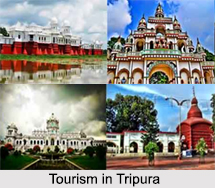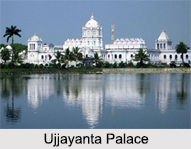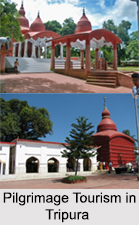 Tourism inTripura owes its splendour to its natural settings and dazzling heritage. The state government has given tourism the status of an industry. A plethora of delightful attractions are comprised in the historical palaces, rock cut carvings, stone sculptures,Hindu and Buddhist temples, wildlife sanctuaries and tribal people. The state has several places of tourist importance like Agartala, Unakoti, Pilak, Udaipur, Tripura Sundari Temple, Ujjayanta Palace, Neermahal, Jampui Hill, Bhuvaneswari Temple, Sepahijala, Kamalasagar Kali Temple, Deotamura and Dumboor Lake.
Tourism inTripura owes its splendour to its natural settings and dazzling heritage. The state government has given tourism the status of an industry. A plethora of delightful attractions are comprised in the historical palaces, rock cut carvings, stone sculptures,Hindu and Buddhist temples, wildlife sanctuaries and tribal people. The state has several places of tourist importance like Agartala, Unakoti, Pilak, Udaipur, Tripura Sundari Temple, Ujjayanta Palace, Neermahal, Jampui Hill, Bhuvaneswari Temple, Sepahijala, Kamalasagar Kali Temple, Deotamura and Dumboor Lake. Moreover, there are the Buddhist monasteries in Agartala, Pecharthal, Kanchanpur, Manu Bakul, Pilak and Boxnagar.
Moreover, there are the Buddhist monasteries in Agartala, Pecharthal, Kanchanpur, Manu Bakul, Pilak and Boxnagar.Pilgrimage Tourism in Tripura
The entire origin of the land of Tripura is steeped in religion. The temple of Tripura Sundari in Udaipur, Tripura is one of the foremost religious shrines in Tripura. The state itself derives its name from the mother goddess. Most of the temples in Tripura are located at hilltops. Besides the Hindu shrines, Tripura is also the abode of Buddhist pilgrimages. Benuban Vihar in Agartala is one of the most attractive Buddhist destinations of Tripura.
Nature Tourism in Tripura
Tripura is endowed with natural landscape of hilly terrain, green vegetation and flowing rivers. It is marked by low ranges running in a north-west to south-east direction. These ranges reach up to 3000 feet. On the road to Udaipur, 35 km south of Agartala, the nature reserve at Sepahijala extends over 18 square kilometers, with a lake, zoo and botanical gardens, and is home to primates including the Hoolock gibbon and golden langur and around 150 species of birds. Trishna Wildlife Sanctuary is located 100 kilometres away from Agartala in South Tripura District. Besides these the travellers can also explore Dumboor Lake, near Agartala and Rudrasagar Lake, near Melaghar.
 Leisure Tourism in Tripura
Leisure Tourism in TripuraThe State Museum at Agartala displays interesting ethnographic and archaeological exhibits. One of its galleries is completely devoted to the excavations at Unakoti in the forests of northern Tripura.
For more, visit the link below: